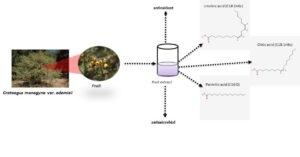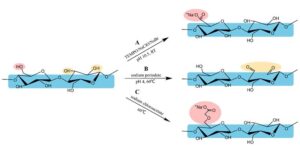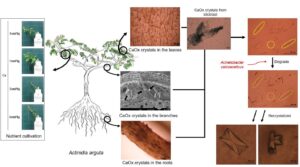Research Articles
Latest articles
- Researchpp 1542-1557Özderin, S. (2024). “Chemical properties, antioxidant, and antimicrobial activities of fruit extracts of Crataegus monogyna var. odemisii,” BioResources 19(1), 1542-1557.AbstractArticlePDF

Fruit of the Crataegus species (Rosaceae), known as the “Hawthorn” wild plant, has important benefits for human health. The purpose of this study was to determine the chemical properties of one of the local endemic taxa, Crataegus monogyna var. odemisii in west Turkey. Based on the chemical analysis results, antioxidant and antimicrobial activities of fruit extracts, the fruit lipid contents, total phenol, and total flavonoid contents were studied. Five different methods were used to measure antioxidant capacity, namely the CUPRAC, β-Carotene-linoleic acid, DPPH•, ABTS•+, and CUPRAC analyses were used for the measurement of antioxidant capacity. The results showed that the highest antimicrobial activity was against C. albicans, and it was more effective against Gr+ bacteria than Gr- bacteria. The qualitative, as well as quantitative, analyses of lipid contents of the fruits of C. monogyna var. odemisii were made by gas chromatographic analysis. Folin-Ciocalteu reagent was used for determining the total phenolic content, and aluminum chloride was used for determining the flavonoid content. Results revealed that there was a statistically significant relationship between the antioxidant activities and the phenolic and flavonoid contents in the extracts of Hawthorn fruits.
- Researchpp 1558-1570Du, H., Mei, J., Fu, W., and Hu, X. (2024). “Experimental research on bending performance of wood-concrete composite slab with screw connections,” BioResources 19(1), 1558-1570.AbstractArticlePDF
The existing research primarily focuses on wood-concrete composite beams, with limited studies on the bending performance and effective width of wood-concrete composite slabs. A full-scale composite slab with screw connections was constructed and subjected to static load testing. The study extensively investigated the ultimate bearing capacity, load-deflection curves, interface slips, strain distributions of cross-section and effective width of the wood-concrete composite slab. It was found that the failure mechanism of the composite slab involved both bending and tensile failure of the wood beams. As the applied load intensified, a marked augmentation in the longitudinal strain of the concrete slab was observed; along the width direction, the longitudinal strain of concrete slab manifested a curved distribution. The precise determination of the effective width of the concrete slab within the composite floor could be accurately achieved via the utilization of a simplified computational approach. In order to simplify the analysis, the M-shaped section of composite slab was approximated as T-section composite beams when evaluating the bending behavior. The linear-elastic model was shown to be accurate in predicting the bending stiffness and load-carrying capacity of composite slabs.
- Researchpp 1571-1589Zhang, W., Wang, T., Zhu, Y., Gao, Y., Liu, L., Li, M., and Zhang, L. (2024). “Fabrication of surface embedded silver cellulose-based flexible transparent electrodes by self-assembly,” BioResources 19(1), 1571-1589.AbstractArticlePDF
Developing eco-friendly, degradable, and flexible electronic devices using renewable cellulose, such as waste agricultural straw, is increasingly vital. This approach tackles the growing issue of nondegradable electronic waste. In this study, flexible transparent electrodes (FTEs) were created using cellulose from waste corn straw, embedding silver nanowires (AgNWs) networks within the surface layer. This method is suitable for reel-to-reel processing. These sustainable FTEs had high transparency and conductivity, with a film resistance of 45.4 Ω/sq and light transmittance of 86.2% at 550 nm. The “dissolution–regeneration” self-assembly process harnesses cellulose’s hydrogen bond network to stabilize the AgNWs network, providing the FTEs with excellent electromechanical stability. Resistance changes were less than 3% during bending, folding, and 1,000-time cyclic bending tests. Furthermore, these electrodes showed remarkable environmental stability, with only a 2.5% resistance increase after 16 days at room temperature. This research demonstrates a new application for agricultural straw cellulose in flexible electronics, offering a sustainable alternative in electronic materials.
- Researchpp 1590-1601Wang, J., Wang, Y., Liu, Z., Shao, X., Lin, Y., Song, W., Xu, D., Gao, Y., and Han, J. (2024). “Modification methods’ effects on the characteristics of carboxylated cellulose fibers: Carboxyl group introduction method versus physical properties,” BioResources 19(1), 1590-1601.AbstractArticlePDF

Cotton fibers were modified by TEMPO oxidation, sodium periodate oxidation, and sodium chloroacetate etherification to obtain carboxylated cellulose fibers with similar carboxyl content (about 70 mmol/100 g). The characteristics of carboxylated cellulose fibers were analyzed by comparing the morphology, chemical structure, crystallinity, carboxyl content, yield, water retention value, degree of polymerization (DP), and cost. The results showed that etherification and oxidation are both important ways to introduce carboxyl groups into the molecular structure of cellulose. When the carboxyl group with similar content is introduced into cellulose, the three modification methods will encourage a certain degree of cellulose degradation. TEMPO oxidation and sodium periodate oxidation will degrade cellulose more obviously, whereas chloroacetate etherification can obtain a higher yield, DP, and lower cost.
- Researchpp 1602-1616Kong, R. K., Goh, J. H., Won, K. R., Shin, H. W., Jang, B. I., Kim, J. W., Kim, C. S., and Byeon, H. S. (2024). “Calcium oxalate crystals and the optimal growing conditions for Actinidia arguta,” BioResources 19(1), 1602-1616.AbstractArticlePDF

The presence, distribution, and morphology of calcium oxalate (CaC2O4, CaOx) crystals were observed in the stunted bodies of Actinidia arguta (A. arguta) vines, and their ability of microorganisms to degrade CaOx crystals was analyzed. Leaves, branches, and roots of stunted A. arguta vines were collected. In the roots, CaOx crystal bundles were distributed in the form of dotted lines. In the branches, CaOx crystal bundles were observed blocking and accumulating in the vessels. In the leaves, CaOx crystal bundles were observed in a net-like entanglement. Therefore, CaOx crystals present in the roots, branches, and leaves hinder the growth. A hydroponic cultivation with different calcium (Ca) concentrations showed that the growth of A. arguta was best at a Ca concentration of 1 cmol+/kg; at a Ca concentration of 2 cmol+/kg, the edges of the leaves began to dry out after 7 days; and at a Ca concentration of 4 cmol+/kg, the entire leaves died within 14 days. From this study, it was concluded that CaOx crystals hindered the growth of A. arguta, and the Acinetobacter calcoaceticus (A. calcoaceticus) strain was effective in degrading CaOx crystals. Therefore, the Ca concentration in the soil of the cultivation site should be managed at less than 2 cmol+/kg.
- Researchpp 1618-1632Lim, D. G., Lee, Y. J., Lee, J. M., Kim, J. H., and Lee, T. J. and Kim H. J. (2024). “Effect of polyhydroxybutyrate and ethyl cellulose for barrier coating of kraft paper,” BioResources 19(1), 1618-1632.AbstractArticlePDF
Poly(3-hydroxybutyrate) (PHB), a biodegradable polymer, has been studied as a substitute for petroleum-based polymers used for barrier coating to improve the barrier and mechanical properties of paper. In this study, ethyl cellulose (EC), a cellulose derivative, was used to prepare a polymer blend for enhancing the barrier properties of PHB. The prepared PHB/EC blend was then applied as a paper coating material. Additionally, the barrier and mechanical properties of the PHB/EC blend-coated paper based on the PHB/EC mixing ratio and coating weight were analyzed. The results showed that the EC could act as a binder for the PHB/EC blend-coated paper. Consequently, the PHB/EC blend-coated paper exhibited significant improvements in mechanical and barrier properties, including a substantial increase of over 100% in internal bond strength, more than 20% in tensile strength, exceeding 60% enhancement in water resistance, and a remarkable increase of over 90% in air permeability.
- Researchpp 1633-1651Hwang, S.-W., Park, G., Kim, J., Kang, K.-H., and Lee, W.-H. (2024). “One-dimensional convolutional neural networks with infrared spectroscopy for classifying the origin of printing paper,” BioResources 19(1), 1633-1651.AbstractArticlePDF
Herein, the challenge of accurately classifying the manufacturing origin of printing paper, including continent, country, and specific product, was addressed. One-dimensional convolutional neural network (1D CNN) models trained on infrared (IR) spectrum data acquired from printing paper samples were used for the task. The preprocessing of the IR spectra through a second-derivative transformation and the restriction of the spectral range to 1800 to 1200 cm-1 improved the classification performance of the model. The outcomes were highly promising. Models trained on second-derivative IR spectra in the 1800 to 1200-cm-1 range exhibited perfect classification for the manufacturing continent and country, with an impressive F1 score of 0.980 for product classification. Notably, the developed 1D CNN model outperformed traditional machine learning classifiers, such as support vector machines and feed-forward neural networks. In addition, the application of data point attribution enhanced the transparency of the decision-making process of the model, offering insights into the spectral patterns that affect classification. This study makes a considerable contribution to printing paper classification, with potential implications for accurate origin identification in various fields.
- Researchpp 1652-1665Piccini, A. M. D., Moura, J. D. M., and Piccini, A. R. (2024). “Literature review and preliminary analysis of cassava by-products potential use in particleboards,” BioResources 19(1), 1652-1665.AbstractArticlePDF
Particle panels for construction are environmentally favorable, as they allow the combination of different components (as is the case with agro-industrial waste from the production and processing of food and products derived from agricultural activities). The objective of this article is to analyze studies focused on the use of cassava by-products in the production of panels for civil construction/furniture in the last 10 years through a bibliographical survey, as well as to present a preliminary analysis of the feasibility of using cassava by-products to manufacture particle panels in their natural state. As a result, the theoretical search detected the gap created by the scarcity of published studies on the topic. On the other hand, the experimental analysis indicated the promising potential of using the cassava by-product for panel production, provided that the weaknesses initially indicated in this research can be addressed.
- Researchpp 1666-1679Yang, S., and Kang, S. (2024). “Assessment of color and contact angle changes in waterborne stained wood under natural weathering condition of South Korea’s summer climate,” BioResources 19(1), 1666-1679.AbstractArticlePDF
This study aimed to develop a waterborne stain (WBS) that protects against weathering and increases resistance of wood to fungi when exposed to heavy rainfall. The WBS was prepared using an antibacterial agent, insect repellent, and copper nanoparticle solution (CN) as a surface coating agent. The WBS was applied on larch and hemlock wood, and changes in color and wettability due to natural and artificial weathering were evaluated. A gray-blue spot developed on the untreated wood surface within 30 d of outdoor exposure, which then spread over the entire wood surface, and the wood eventually turned black. Resistance to fungi increased when CN alone was applied; however, the CN surface was oxidized and turned gray after 30 d and 90 d for larch and hemlock, respectively. The water contact angle was increased due to leaching. The application of CN followed by WBS prevented wood discoloration under ultraviolet light and the wood showed excellent weathering resistance capacity. The prevention of wood discoloration and resistance to fungi by CN were confirmed, which could guide the development of a paint that can prolong protection from weathering of wood exposed to heavy rainfall events.
- Researchpp 1680-1695Ezung, B., Kalivarathan, R., Khusro, A., Agastian, P., Almutairi, B. O., and Arokiyaraj, S. (2024). “In vitro assessment on anti-inflammatory and anti-lipidemic properties of selected plant species,” BioResources 19(1), 1680-1695.AbstractArticlePDF
Preliminary assessment for anti-inflammatory and anti-lipidemic properties was done with different solvent extracts derived from Urtica urens and Polygonum chinense leaves through in vitro experimentation. To evaluate anti-inflammatory properties, the stability of human red blood cells membranes and the denaturation activity of proteins were assessed. For anti-lipidemic effects, an assay was conducted to measure the inhibition of HMG-CoA reductase. The results of membrane stabilization showed IC50 values of 480.96 ± 0.02 and 319.41 ± 0.19 µg/mL for ethyl acetate extract of U. urens and P. chinense, respectively. The standard drug Diclofenac sodium exhibited IC50 value of 240.37 ± 0.04 µg/mL. For protein denaturation, IC50 values were determined as 221.75 ± 0.2 and 315.76 ± 0.19 µg/mL for U. urens and P. chinense, respectively. The IC50 value of the standard drug was calculated as 126.7 ± 0.34. The IC50 values towards HMG-CoA reductase inhibition were subsequently determined as 29.84 ± 0.35 µg/mL for U. urens and 24.34 ± 0.04 µg/mL for P. chinense against the standard drug Diclofenac sodium (7.52 ± 0.43 µg/mL). GC-MS chromatograms revealed the presence of bioactive compounds in ethyl acetate extract of P. chinense leaves. This work is substantiation for the traditional therapeutic utilization of these extracts.
